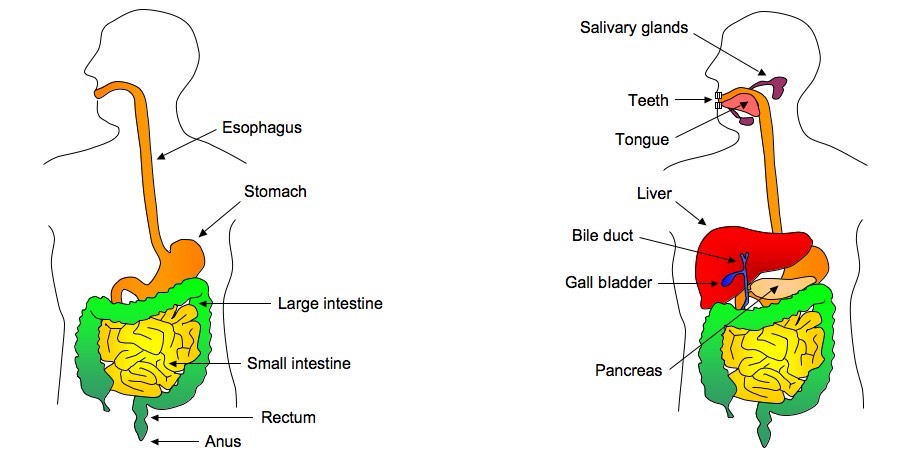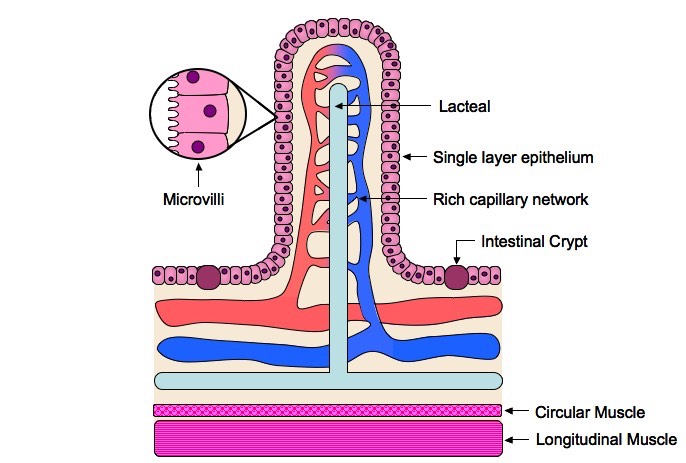6.1.1 Explain why digestion of large food molecules is essential
Most food is solid and in the form of large complex molecules which are insoluble and chemically inert (not readily usable)
- As food was synthesised by other organisms, it contains materials not suitable for human tissue - these need to be separated and removed
- Large molecules need to be broken down into smaller molecules that can be readily absorbed across membranes and into cells
- Small molecules can be reassembled into new products (e.g. amino acids can be reassembled to make new proteins)

6.1.2 Explain the need for enzymes in digestion
- Enzymes are biological catalysts which speed up the rate of a chemical reaction (e.g. digestion) by lowering the activation energy
- Enzymes allow digestive processes to occur at body temperature and at sufficient speed to meet the organism's survival requirements
- Enzymes are specific for a given substrate and so can allow digestion of certain molecules to occur independently of others
6.1.3 State the source, substrate, product and optimal pH conditions for one amylase, one protease and one lipase

6.1.4 Draw and label a diagram of the human digestive system
There are two major groups of organs that comprise the human digestive system:
- Alimentary Canal: Contains organs through which the food actually passes (esophagus, stomach, small intestine, large intestine, etc.)
- Accessory Organs: Organs that assist in digestion but no food passes through them (liver, pancreas, gall bladder, salivary glands, etc.)
Alimentary Canal Accessory Organs

6.1.5 Outline the function of the stomach, small intestine and large intestine
Stomach
- The stomach acts as a temporary storage tank and is where protein digestion begins
- The stomach contains gastric glands which secrete digestive juices for chemical digestion
- Acids create a low pH environment (pH~1-2) that denatures proteins, while proteases like pepsin hydrolyse large proteins
- The stomach also releases a hormone (gastrin) that regulates stomach secretions
- The mechanical action of the stomach (churning) also promotes digestion by mixing the food
- The stomach turns food into a creamy paste called chyme
Small Intestine
- The small intestine is where usuable food substances (e.g. nutrients) are absorbed into the bloodstream
- The pancreas and gall bladder (via the bile duct) both secrete substances into the small intestine to aid in digestion
- The small intestine is lined with smooth muscle to allow for the mixing and moving of digested food products (via segmentation and peristalsis)
- It also contains small pits (crypts of lieberkuhn) that secrete intestinal juices
- The small intestine contain infoldings called villi, to increase surface area and optimise the rate of absorption
Large Intestine
- The large intestine absorbs water and dissolved minerals from the indigestible food residues, and by doing so converts what remains from a fluid state into a semi-solid faeces
- The faeces is stored in the rectum and eliminated out the anus
6.1.6 Distinguish between absorption and assimilation

Absorption: The movement of a fluid or dissolved substances across a membrane
Assimilation: The conversion of nutrients into fluid or solid parts of an organism
Hint: Absorption is taking it into something, assimilation is making it a part of something
6.1.7 Explain how the structure of the villus is related to its role in absorption and transport of products of digestion
Microvilli: Greatly increase the surface area of the villus, allowing for a greater rate of absorption
Rich capillary networks: Help to maintain a concentration gradient for absorption by rapidly transporting absorbed products away
Single epithelial layer: Ensures minimal diffusion distance between the intestinal lumen and capillary network
Lacteals: Absorb lipids from the intestine into the lymphatic system (which are later reabsorbed back into normal circulation)
Intestinal crypts: Located between villi and release juices that act as a carrier fluid for nutrients
Membrane proteins / mitochondria: High amounts to enable active transport into cells (contents then passively diffuse into bloodstream)
Features of a Villus
